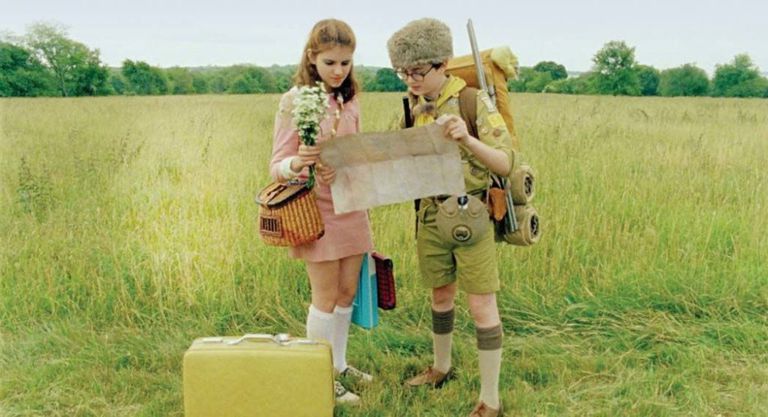Blueprints: "Moonrise Kingdom"
 Thursday, March 29, 2018 at 5:27PM
Thursday, March 29, 2018 at 5:27PM With the release of Isle of Dogs, Jorge looks into an earlier Wes Anderson film...

While Wes Anderson’s characteristic and by now immediately recognizable cinematic style evokes mainly the images of perfectly centered frames, bright-color palettes, and characters covered in quirks and oddities, not everything about him is visual. The patterns of speech from his characters are almost lyrical, and his stories are filled with strong undercurrents of nostalgia, melancholy, and growing pains.
All of his worlds evoke a kind of diorama construction. Though the production design on most movies only happens just before principal photography, Anderson paints an image of what he wants his frames to look like right from the first pages of each script. Let’s take a look at a highly stylized (yes, even more than usual) sequence from Moonrise Kingdom too see how painstakingly meticulous the details are from the very start...
Moonrise Kingdom
Written by: Wes Anderson and Roman Coppola
[You can read the full script here. I will be talking about these pages and this scene.]
By this point in the movie, Sam and Suzy have met up in the meadow, after each escaping their respective oppressive family units. As they stare at each other, standing in the corners of the frame, we cut to a montage that explains how their relationship evolved from a casual encounter at a dressing room, to pen pal romance, to eloping.
The script tells us right away that what we are going to witness is a “montage of Sam and Suzy’s correspondence history.” It will be made up of small vignettes; different setups of Sam and Suzy’s lives as they continued to write each other. These are quick moments that make up a relatively small portion of both the script and the film’s runtime, but that Wes Anderson describe with meticulous detail, even for scenes that are barely seconds long.

The script describes everything, from the clothes that the characters are wearing (“a greasy jumpsuit”) to almost the exact blocking that the actors will be following (““Suzy writes at a small desk on the upstairs landing while Lionel and Murray play a loud duet on a red piano behind her”). It dives into the minutia of the colors of the objects, and the specific type of props that should be used. It reads more like the description of a painting, which is appropriately what Wes Anderson frames feel like.
The dialogue is told through the voiceover of the characters. It is not a coherent, single conversation, bur rather excerpts of the various letters that Sam and Suzy exchanged through the years. The stories they tell are fragmented, which is why a montage was the perfect device to project it visually.

We only listen to pieces of the letters with incomplete sentences, but they are arranged in a way where it is understood and explicit that they are referencing incidents or answering questions asked in the letter before (“Dear Suzy, I know your parents hurt your feelings…”, “Dear Sam, I do think you should think of their faces every day…”). This paints a clear picture of the quickly-evolving intimacy between the two kids.
As the letters progress, and Sam and Suzy get more acquainted and romantically involved with each other, the letters get shorter, and the images in the montage simpler, though they are still described in detail (“A sheet of wide-ruled yellow paper which reads in a boy’s penciled scrawl”). What started out as elaborate descriptions of scenery, with intricate stories in the voiceover, ends up in simple inserts of paper, and one-word back-and-forths.

The letter montage is not only a direct visual representation of the way Sam and Suzy’s relationship evolved with such a quick pace, but it’s also a small sample of what makes Wes Anderson’s style so distinctive, both on screen and on the page.
It is not easy to translate the visual into words, especially a style as eclectic, particular, and saturated as Wes Anderson’s worlds. But as it turns out, his writing style is nothing if consistent with his images. It is meticulously crafted: word by word, frame by frame. And he fills up every space of the story with something that bears his incomparable brand.



Reader Comments (2)
Wonderful film.
What a pleasure to have articles on BOTH "Moonrise Kingdom" and "The Royal Tenenbaums" this week, the only two Wes Anderson movies that I love.
Anderson's meticulous artistry can give so many satisfactions, and I love how you've chosen and articulated this thread.
I like it when Anderson's artistry is applied to a movie that has heart and a depth of feeling. His movies with female protagonists are so much better than the ones with almost all male casts, where the stories seem to rarely slow down or make room for emotion.
The two leads in "Moonrise Kingdom" are so loveable in their unloveableness.